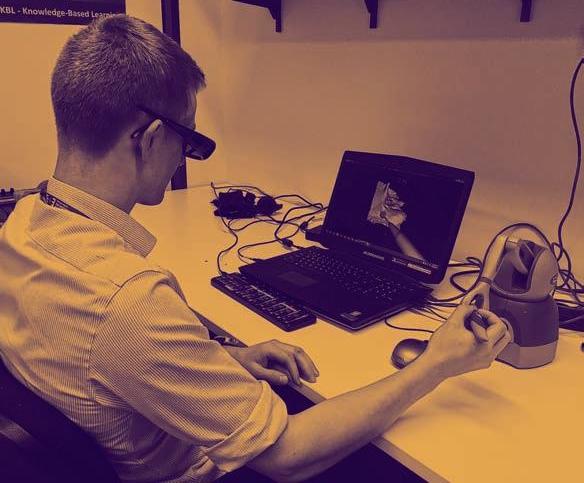
3 minute read
SURGICAL SIMULATION BEN TALKS
from ONA 106
SURGICAL SIMULATION
In some non-sporting news BEN TALKS (07-14) writes about unusual work experience in Melbourne.
Advertisement
Above: 3D printed temporal bone Opposite: Ben working on his surgical skills on the University of Melbourne Temporal Bone Simulator
Over the summer I spent three months
in the Department of Otolaryngology at the University of Melbourne based in the Royal Victorian Eye and Ear Hospital. Behind the hospital lies ‘Bionic Ear Lane’, a reminder of the illustrious past of the department, which invented the cochlear implant and carried out the first human cochlear implant operation in 1978.
Cochlear implants (otherwise known as bionic ears) have since revolutionised the management of hearing loss worldwide, with 1,504 implants taking place last year in the UK alone.
The department remains a centre of innovation, more recently developing the University of Melbourne Virtual Reality Temporal Bone Simulator as a risk free teaching modality for surgical trainees to learn ear surgery. It is one of five such devices to have been developed worldwide and was the focus of my placement.
Virtual reality is a computer generated environment that uses a range of sensory stimuli to immerse the user in the experience, including visual, haptic (touch), and auditory cues. It is increasingly being used to prepare employees for a range of jobs from Walmart supermarket assistants, to astronauts, to pilots, to surgeons. The simulator presents a 3D image of a temporal bone (the skull bone in which the delicate structures of the ear are located), which users
can ‘feel’ and interact with using a virtual drill provided by a haptic arm. Each of the nine ‘patients’ on the simulator were created from radiographic images of human cadaveric temporal bones. Further, the simulator can provide instruction on how to carry out several operations through procedural guidance, where each step of the operation is sequentially highlighted in green, and artificial intelligence generated verbal feedback on drilling technique.
The 10,000-hour rule, popularised by Malcom Gladwell’s book Outliers, describes the length of time engaged in practice required to become a world expert in a field. Surgical training has traditionally been based upon the apprenticeship model, where trainees are supervised by an expert surgeon according to the mantra of “see one, do one, teach one”. However, as job roles evolve and the working hours of surgical trainees reduce, currently limited to 48 hours per week in the UK as part of the wider European Union working hours directive, it is hard for trainees to gain sufficient operative experience.
Cadaveric dissection is one of the oldest forms of surgical training and remains the goldstandard teaching technique for surgical trainees. However, cadaveric temporal bones are in short supply and are not without their own disadvantages, including the risk of blood borne viruses and accompanying need for restrictive laboratory conditions. Learning surgical skills directly through practice on patients presents obvious risks to the patients being operated on by inexperienced practitioners. Virtual reality surgical simulation intuitively presents an opportunity for surgical trainees to gain far greater operative experience than possible by traditional teaching methods in a risk free environment. Would you rather be operated on

by a trainee who had performed a single cortical mastoidectomy on a cadaveric temporal bone, or one who had performed the procedure a thousand times in virtual reality?
Before the widespread adoption of virtual reality simulation into surgical training, high quality evidence is needed demonstrating adequate skill transfer from the virtual environment to physical media. In other words, if you can successfully complete an operation in virtual reality can you also perform the procedure in the operating theatre? To investigate this I carried out a study recruiting university students to learn to carry out a cortical mastoidectomy (a relatively simple and very common ear operation) on the University of Melbourne Temporal Bone Simulator, and then carry out two operations on 3D printed temporal bones using a real drill.
An obvious additional benefit of this placement was the opportunity it gave me to travel to Australia. Having got hooked on rock climbing during my time at RGS I’ve never looked back and took every chance to check out the local rock climbing. Fortunately for me, Victoria is home to some world class rock climbing destinations, namely the Grampians National Park and Mount Arapiles National Park. In these national parks, the towering sandstone faces of prehistoric sea cliffs offer a lifetime’s worth of adventure, with the added bonus of a plethora of unusual Australasian wildlife including kangaroos, ‘stumpy’ lizards, and of course snakes.










